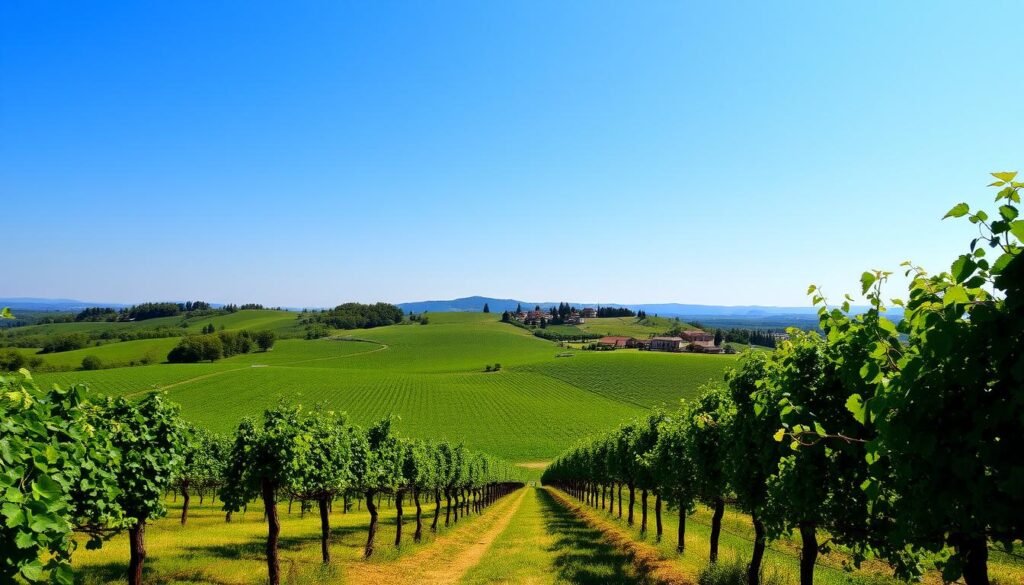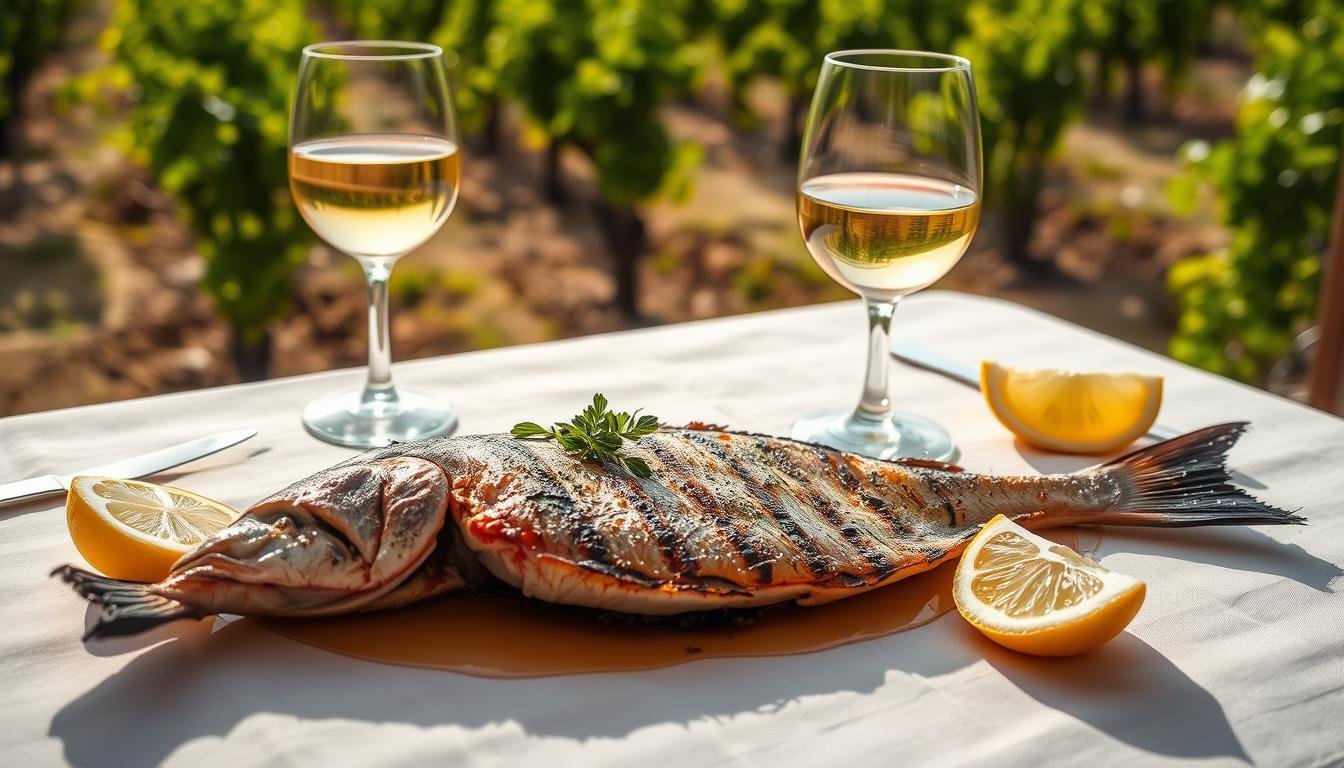Discover the rich diversity of Italian wine regions, where 20 distinct areas span from the Alpine north to the Mediterranean south.
The country’s complex wine landscape can be challenging to navigate due to its esoteric labeling system and numerous indigenous grape varieties.
The Italian wine classification system, including DOC, DOCG, and IGT designations, helps consumers identify quality and regional authenticity.
This comprehensive guide will help you explore the intricate wine map, understand the characteristics of major regions, and discover the perfect wines to try during your Italian journey.
Key Takeaways
- Understand the diversity of Italian wine regions.
- Learn about the Italian wine classification system.
- Discover the characteristics of major wine regions.
- Explore the perfect wines to try during your Italian journey.
- Navigate the complex Italian wine landscape with confidence.
Understanding the Italian Wine Landscape
From the Alps to Sicily, Italy’s wine regions showcase a remarkable range of terroirs and wine styles. Italy’s long boot-shaped peninsula is familiar to most people, and its long coastlines mean that wine-growing areas close to the sea are tempered by cooling sea breezes. Yet, Italy is also a mountainous country with the Alps and Dolomites in the north and the Apennines forming the backbone of the country.
The Complexity of Italian Wine Classification
Italian wine classification is complex, with a system that includes several categories such as DOCG, DOC, and IGT. Understanding these classifications can help navigate the vast world of Italian wines. For those interested in exploring more about wine regions, visit Wine Kalli for additional insights.
Navigating Italy’s 20 Wine Regions
Italy is divided into 20 wine regions, each with its unique characteristics. Some of the most renowned regions include Piedmont, known for Barolo and Barbaresco, and Tuscany, famous for Chianti and Brunello. The concept of terroir is particularly important in Italian winemaking, with the country’s diverse geography creating numerous microclimates ideal for different grape varieties.
- Elevation plays a crucial role in Italian viticulture, with many premium wine regions located on hillsides and mountains.
- Soil composition varies dramatically across the italy wine map, from limestone and clay to volcanic soils.
- Maritime influences moderate temperatures in coastal regions, affecting ripening patterns and wine styles.
Key Factors Influencing Italian Terroir
The diverse geography of Italy creates a wide range of terroirs, each influencing the local grape varieties and wines. Historical winemaking traditions have helped Italian producers identify which grape varieties thrive in specific terroirs, leading to the development of hundreds of indigenous varieties uniquely adapted to local conditions. This rich production of diverse wines has made Italy renowned in the world of wine.
Northern Italy Wine Map: Alpine Influences & Prestigious Vineyards
Exploring Northern Italy’s wine map reveals a complex tapestry of wine regions, each with its own distinct character. The Alpine influences and prestigious vineyards in this area make it a fascinating destination for wine enthusiasts.

Piedmont: Home of Barolo & Barbaresco
Piedmont is renowned for its high-quality wines, particularly Barolo and Barbaresco, made from the Nebbiolo grape. These wines are known for their complexity and aging potential. The region’s unique terroir, with its mix of clay, sand, and limestone soils, contributes to the distinct flavor profiles of its wines.
Veneto: Valpolicella, Amarone & Prosecco Country
The Veneto region is famous for its Valpolicella and Amarone wines, made from dried Corvina grapes. Prosecco, another popular wine from this region, is produced using the Glera grape. Veneto’s diverse terroir and climate allow for a wide range of wine styles, from still wines to sparkling wines like Prosecco.
Trentino-Alto Adige & Friuli-Venezia Giulia: White Wine Excellence
Trentino-Alto Adige and Friuli-Venezia Giulia are known for their white wines, made from grapes such as Chardonnay, Pinot Grigio, and Friulano. The cool climate and diverse soils in these regions contribute to the freshness and complexity of their white wines. These regions are ideal for those looking to explore Italy’s white wine offerings.
Lombardy & Valle d’Aosta: Hidden Alpine Treasures
Lombardy is home to Franciacorta, Italy’s premier sparkling wine region, producing metodo classico sparkling wines that rival Champagne. Valle d’Aosta, the smallest wine region in Italy, produces distinctive wines from indigenous grapes like Petit Rouge and Petite Arvine. Both regions offer unique wine experiences amidst spectacular Alpine scenery.
For those interested in exploring more of Italy’s wine regions, a visit to Italian wine tours can provide valuable insights and planning resources.
Central & Southern Italy Wine Regions: From Tuscany to Sicily
From the rolling hills of Tuscany to the sun-kissed islands of Sicily and Sardinia, Central and Southern Italy boast an incredible array of wine regions. This diverse landscape is home to a wide range of grape varieties, wine styles, and production methods, making it a fascinating area to explore for wine enthusiasts.

Tuscany: Exploring Chianti, Brunello & Super Tuscans
Tuscany is one of Italy’s most famous wine regions, known for its Chianti, Brunello di Montalcino, and Super Tuscan wines. The region’s diverse terroir, which includes clay, limestone, and sand soils, contributes to the complexity of its wines. For those interested in exploring Tuscany’s wine scene, wine region guides can provide valuable insights into the best vineyards and wine tours.
Umbria, Marche & Abruzzo: Central Italy’s Wine Gems
Moving south from Tuscany, the regions of Umbria, Marche, and Abruzzo offer a wealth of wine experiences. Umbria is known for its Sagrantino wines, while Marche is famous for its Verdicchio. Abruzzo, with its Montepulciano d’Abruzzo, rounds out this trio of wine gems. Each region has its unique grape varieties and wine styles, making them worth visiting for any wine enthusiast.
Campania & Puglia: Southern Powerhouses
Campania and Puglia are two of Southern Italy’s wine powerhouses. Campania is home to the ancient grape variety Fiano, used in Fiano di Avellino, and the iconic Lacryma Christi del Vesuvio. Puglia, on the other hand, is known for its Primitivo and Negroamaro wines, which thrive in the region’s warm climate. Both regions are must-visits for those looking to explore the rich wine culture of Southern Italy.
Sicily & Sardinia: Island Wine Traditions
Sicily and Sardinia, the Mediterranean’s largest islands, represent two of Italy’s most exciting wine regions. Sicily has undergone a remarkable quality revolution, with wines made from indigenous varieties like Nero d’Avola and Carricante gaining international recognition. Sardinia, with its Cannonau and Vermentino wines, offers a unique wine experience shaped by its island terroir and maritime influences. For those interested in exploring these island wine traditions, visiting the islands and tasting the wines firsthand is a must.
The wine regions of Central and Southern Italy are not just about the wines; they’re also about the rich cultural heritage and history that these regions embody. From the medieval hill towns of Tuscany to the ancient ruins of Sicily, the cultural landscape is as diverse as the wines themselves. As you explore these regions, you’ll discover that the wines are an integral part of the local culture and traditions.
Planning Your Italian Wine Journey
From the Alps to the Mediterranean, Italy’s wine regions beckon exploration. With 20 wine regions, each offering a unique terroir and variety of wines, the possibilities for a wine journey through Italy are endless.
Consider focusing on one Italy wine region to gain an in-depth understanding, or plan a north-to-south journey to experience the remarkable diversity of Italian wines. Many wineries require advance reservations for tastings, particularly in prestigious areas like Barolo and Brunello di Montalcino.
Regional wine festivals and sagre (local food festivals) offer excellent opportunities to taste multiple wines from an area alongside traditional foods. Timing your visit around harvest season (September-October) can provide a unique experience of vendemmia (grape harvest) and see wineries in full production mode.
Exploring Italy’s wine regions is as much about food as it is about wine. Each region has distinctive culinary traditions that have evolved alongside local wines to create perfect pairings. Whether you choose a self-guided tour with a good Italy wine map or opt for guided experiences, learning a few Italian wine terms will enhance your experience.
By embracing the Italian philosophy of enjoying wine as part of daily life and meals, you’ll truly understand the soul of Italian wine. With its rich variety of red wines and white wines, Italy is a paradise for wine lovers. Book your Italy Food & Wine Tour now to discover Italy’s renowned vineyards and indulge in 5-star hospitality and dining.
FAQ
What are the most renowned Italian wine regions?
Tuscany, Piedmont, and Veneto are among the most celebrated regions, known for producing high-quality wines like Chianti, Barolo, and Prosecco.
What is Vino Nobile di Montepulciano?
Vino Nobile di Montepulciano is a DOCG red wine produced in Tuscany, made from the Sangiovese grape variety, known for its complex flavors and aging potential.
Which grape varieties are commonly used in Italian winemaking?
Italy is home to a diverse range of grape varieties, including Sangiovese, Nebbiolo, and Nero d’Avola, each contributing to the country’s rich wine diversity.
What is the significance of terroir in Italian winemaking?
Terroir plays a crucial role in shaping the flavor profiles and quality of Italian wines, with factors like soil, climate, and altitude influencing the final product.
Are there any notable sparkling wines produced in Italy?
Yes, Italy is famous for its Prosecco and Franciacorta, both high-quality sparkling wines produced using traditional methods, with Prosecco hailing from Veneto and Franciacorta from Lombardy.
How do I navigate Italy’s 20 wine regions?
Understanding the unique characteristics of each region, such as the grape varieties and wine styles, can help you navigate the diverse world of Italian wines.
What are some must-visit wine regions in Northern Italy?
Piedmont, Veneto, and Friuli-Venezia Giulia are standout regions in Northern Italy, offering a range of wine experiences and high-quality wines.
Can you recommend some red wines from Italy?
Some iconic Italian red wines include Barolo, Brunello di Montalcino, and Amarone della Valpolicella, each offering a distinct taste experience.









